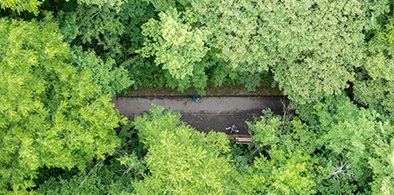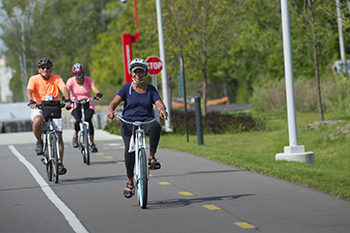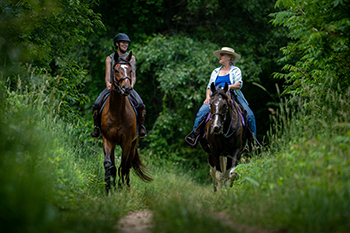DNR: State’s new trails plan embraces growing user base, regional collaboration

 A new comprehensive statewide trails plan provides an updated framework, over 10 years, for the Michigan Department of Natural Resources’ management of the more than 13,400 miles of state-designated trails and pathways that welcome hiking, horseback riding, biking, snowmobiling, off-roading and other outdoor enjoyment every year. A new comprehensive statewide trails plan provides an updated framework, over 10 years, for the Michigan Department of Natural Resources’ management of the more than 13,400 miles of state-designated trails and pathways that welcome hiking, horseback riding, biking, snowmobiling, off-roading and other outdoor enjoyment every year.
It’s all part of the DNR’s efforts to cement Michigan’s reputation as the Trails State. The 2022-2032 Michigan DNR Trails Plan – built around the concept of “explore, connect, sustain” – recognizes the evolution of diverse trail opportunities statewide, balances the many priorities placed on public lands and waters, and identifies key goals toward ensuring the relevance and quality of four-season motorized and nonmotorized trail recreation. |
 “It’s no secret that Michigan’s trails have a consistently positive impact on our residents’ quality of life and the state’s tourism and economy, and the benefits really are far-reaching,” said Ron Olson, chief of the DNR Parks and Recreation Division. “During the COVID-19 pandemic, the value of having trails and pathways close to home where people could safely spread out and relax became even more apparent. “It’s no secret that Michigan’s trails have a consistently positive impact on our residents’ quality of life and the state’s tourism and economy, and the benefits really are far-reaching,” said Ron Olson, chief of the DNR Parks and Recreation Division. “During the COVID-19 pandemic, the value of having trails and pathways close to home where people could safely spread out and relax became even more apparent.
“We’re excited to have worked with our partners and the public to create an updated plan for a sustainable trails system that connects communities, promotes healthier lifestyles and invites more people to explore outdoors.” Olson said the new plan recognizes the growing use of state-designated trails and pathways, takes a more holistic approach that considers all trail users’ needs and wants, recognizes the history and impact of interpretive trails, and aims to create greater equity of access to all trails. |
 Another goal of the 10-year plan is leveraging existing partnerships and building new ones to advance a regional management approach that considers multiple trail uses within the region, in conjunction with available resources and sustainability. Another goal of the 10-year plan is leveraging existing partnerships and building new ones to advance a regional management approach that considers multiple trail uses within the region, in conjunction with available resources and sustainability.
A series of “launch steps” – actions on which the DNR can first focus its resources – are identified, too. They include:
|
Building on the benefits
 Trails provide opportunities for improving mental and physical fitness, connecting with all types of nature and socializing with friends and family. Trails provide opportunities for improving mental and physical fitness, connecting with all types of nature and socializing with friends and family.
Additionally, a phone survey conducted as part of the 2017 Statewide Comprehensive Outdoor Recreation Plan showed that as many as 79% of Michiganders participate in some form of outdoor recreation. Trail use – part of the overall outdoor recreation industry that contributes an estimated $9.5 billion a year to Michigan’s economy – supports small businesses that provide services and rentals for land and water trail users and also supports jobs for those who maintain, build or service trails across the state. The trails plan was developed over the past two years with assistance from Public Sector Consultants and full engagement of the DNR’s trail advisory groups, trail clubs, stakeholders and DNR staff. There was a robust general public input process facilitated by the consultant in fall 2021 that included seven virtual public meetings and an online survey. In July 2021, the Michigan Trails Advisory Council unanimously passed a resolution of support for the new 10-year plan, which replaces the 2013 Comprehensive Trail Plan. The 2022-2032 Michigan DNR Trails Plan is available at Michigan.gov/DNRTrails or the state parks, trails and waterways management resources webpage. For more information, contact Nikki Van Bloem, Southeast Michigan trails specialist, at 517-388-7043 or VanBloemN@Michigan.gov, or Dakota Hewlett, nonmotorized trails grant coordinator, at 517-331-0280 or HewlettD@Michigan.gov, both in the DNR Parks and Recreation Division. |

























